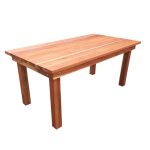 When the word table entered English sometime before the tenth century, it did not refer to an article of furniture found in a kitchen—or anywhere else for that matter—but rather to a wooden board or a flat slab of rock. Not surprisingly, therefore, when table did shift in meaning at the beginning of the fourteenth century, it first came to mean a compact surface made of stone, wax, or other material used for writing upon. It was not until late in the fourteenth century that table came to mean a flat surface with legs, upon which food is served. Nor was this the end of the word’s expansion of meaning: in the late fifteenth century the plural tables came to mean the two sides of a backgammon board; an unlucky player would turn the tables—or in other words rotate the board—to try to change his fortune. The Latin tabula is the ultimate source of table, and from this Latin word English also gets tablet—literally meaning little table—and tabloid. The word tabloid was devised in 1884 by an American pharmaceutical company as the trademark name for a pill-sized tablet of concentrated medicine; however, by the beginning of the twentieth century, the concentrated sense of tabloid led to its being applied to the smaller, “condensed” newspapers we now know as tabloids.
When the word table entered English sometime before the tenth century, it did not refer to an article of furniture found in a kitchen—or anywhere else for that matter—but rather to a wooden board or a flat slab of rock. Not surprisingly, therefore, when table did shift in meaning at the beginning of the fourteenth century, it first came to mean a compact surface made of stone, wax, or other material used for writing upon. It was not until late in the fourteenth century that table came to mean a flat surface with legs, upon which food is served. Nor was this the end of the word’s expansion of meaning: in the late fifteenth century the plural tables came to mean the two sides of a backgammon board; an unlucky player would turn the tables—or in other words rotate the board—to try to change his fortune. The Latin tabula is the ultimate source of table, and from this Latin word English also gets tablet—literally meaning little table—and tabloid. The word tabloid was devised in 1884 by an American pharmaceutical company as the trademark name for a pill-sized tablet of concentrated medicine; however, by the beginning of the twentieth century, the concentrated sense of tabloid led to its being applied to the smaller, “condensed” newspapers we now know as tabloids.
